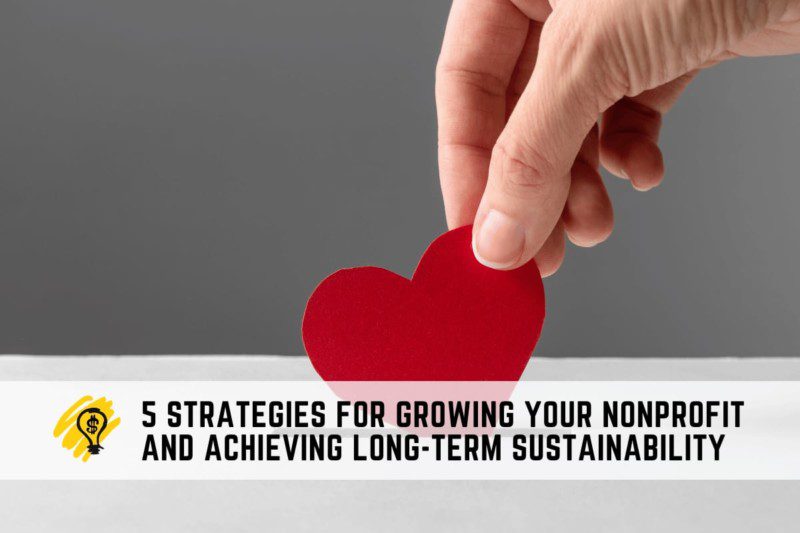As a nonprofit organization, finding ways to grow and sustain your organization in the long term is a challenging but essential task. Not only do you need to focus on your mission and the needs of the community you serve, but you also have to consider the various financial, operational, and logistical issues that come with running a nonprofit.
This is no easy feat, but with the right strategies in place, your nonprofit can reach its growth goals and become a thriving force for good. On that note, here are five strategies for growing your nonprofit and achieving long-term sustainability.
Embrace Technology and Digital Transformation
Utilizing technology and embracing digital transformation can help your nonprofit in a number of ways. For example, online fundraising platforms such as GoFundMe and Kickstarter can make it easier for you to reach a wider audience and secure donations. Data analytics tools can help you track the success of your campaigns and understand the needs of your target audience. Even CRM systems can help you better manage relationships with donors and other stakeholders.
Implementing nonprofit technology and digital transformation can seem daunting, especially if your organization is used to traditional methods. But the benefits are significant, and there are resources available to help you get started. If you’re unsure of where to begin, reach out to a professional digital strategist who can assist you in creating an effective roadmap.
Build Partnerships and Collaborations
Partnering with other organizations and individuals can be a great way to grow your nonprofit. For example, if you’re focusing on environmental sustainability, teaming up with other like-minded organizations can give you access to more resources and a wider network. You could also partner with businesses that may be able to provide financial support or even volunteer their services.
Collaborations can also help you reach new audiences and expand your brand. Consider hosting events or webinars with other nonprofits, businesses, and influencers to create a buzz around your cause. You could also contribute content to websites or publications that reach your target audience.
To initiate a partnership, start by identifying organizations or businesses that align with your mission and goals. Reach out to them with a proposal outlining the potential benefits of a partnership and how you envision working together. Be sure to clearly communicate your needs and expectations and be open to negotiation.
Diversify Funding Sources
Relying on a single funding source, such as grants or donations from a single large donor, can be risky for a nonprofit. If that source dries up or changes priorities, it can leave your organization in a difficult position. As such, diversifying your funding sources can help mitigate this risk and provide more stability for your organization.
There are many potential funding sources for nonprofits, including grants, corporate sponsorships, individual donors, and earned income through services or products. Consider which sources align best with your mission and goals, and research organizations or programs that offer funding in those areas. It’s also a good idea to have a fundraising plan in place that outlines your strategy for securing funding from multiple sources.
Engage and Retain Volunteers
Volunteers play a crucial role in the success of many nonprofits, providing valuable time, skills, and resources. Engaging and retaining volunteers can help your organization run more efficiently and effectively, as well as provide a sense of community and fulfillment for those who volunteer.
To recruit volunteers, consider reaching out to local schools, community centers, or professional organizations to find individuals who may be interested in volunteering. It’s also a good idea to clearly communicate the time commitment and responsibilities involved, as well as the benefits of volunteering for your organization. Once you have volunteers on board, be sure to show appreciation for their efforts and make sure they feel valued and supported.
Just as in the traditional business world, retention is key. Make sure to provide ongoing training and development opportunities for volunteers, as well as recognition and rewards that show you value their contributions.
Utilize Social Media and Online Marketing
Social media and online marketing are essential tools for any nonprofit. Not only can you use them to raise awareness of your mission and goals, but they can also be used to engage and mobilize supporters, as well as reach new audiences.
The key is knowing which platforms to use and how to use them effectively. Start by identifying the social media platforms that your target audience is most likely to use and create content that resonates with them. You can also use online ads to target specific audiences and promote your cause.
Finally, don’t forget about the power of email marketing. With a well-crafted email list, you can easily reach out to current and potential supporters to keep them up-to-date on your organization’s progress and solicit donations.
Wrapping up
By using these strategies, you can ensure that your nonprofit is well-positioned for success in the long term. Whether it’s diversifying funding sources, engaging and retaining volunteers, or embracing technology, there are numerous ways to foster growth and sustainability.
Just remember that running a nonprofit isn’t a one-size-fits-all endeavor. Every organization is unique and will have its own set of needs, goals, and challenges. With this in mind, take the time to understand your organization and its objectives, and be open to new ideas and collaborations. You never know what opportunities may arise!



